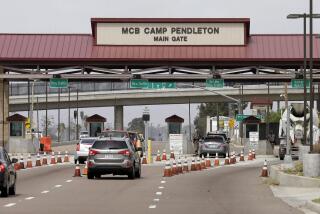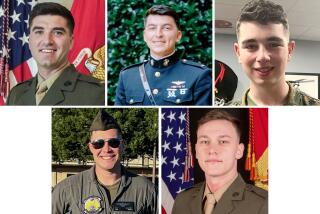Navy Works to Take Lethal Prefix Out of ‘Murdercycles’
For the Navy, there is an apt nickname that sailors give motorcycles: murdercycles.
Sailors in California, which is home to more sailors and Marines than any other state, accounted for one-third of all Navy motorcycle fatalities worldwide. Last year, motorcycle accidents in California killed 16 sailors; 13 were in San Diego. And more than 3,500 days of work at California bases were lost because of motorcycle injuries last year, said Capt. Robin Shoop, director of shore safety at the Naval Safety Center in Norfolk, Va.
“Motorcycles are a way of life here in California,” said Rear Adm. John W. Adams, commander of the Naval Base San Diego. “For the miles ridden, you suffer a greater chance of serious injury than you do driving a car. And, unfortunately, I see that among servicemen.”
In Southern California, where temperatures allow year-round riding and real estate is becoming increasingly expensive, more and more sailors are using motorcycles to travel longer distances to work, said Adams.
Motor vehicle accidents have killed and injured more sailors in recent years than any other cause--including on-duty accidents. About 10% of all sailors ride them, but motorcycles claim a disproportionate share of Navy vehicle accidents, about 23%, said Dr. Nevil Moore of the Naval Safety Center’s motor vehicle safety division.
To combat the accident toll, Shoop and others are stepping up a safety campaign, which has been successful in recent years. Since December, 1985, the Navy started requiring that all sailors attend a 20-hour motorcycle safety class, which started in 1979 as a voluntary course. In California that year, the situation had become serious: 28 sailors has been killed in motorcycle accidents, and injuries accounted for 14,178 lost workdays.
Today, the safety campaign has begun to take hold. Sailors who want to ride a bike on base must attend the course and obtain a decal. They must wear approved helmets, hard-sole shoes and eye protection such as goggles, visors or safety glasses. Officials also recommend that riders wear long-sleeve jackets, long pants, gloves and reflective vests.
But officials lack the clout to enforce the regulations off base. Although Tom Cruise in the 1986 movie Top Gun proved to be a tremendous boon to Navy recruiting, the shots of the calculatedly cool pilot on his motorcycle zipping bare-headed through San Diego did little for safety campaigns and a lot for motorcycle sales, retailers and sailors say.
“I feel proud of a bike like this,” said Brad Chamberlain, 21, patting his 1986 Honda Interceptor, which he said can accelerate from zero to 50 m.p.h. in seconds. “It’s part of a fast-paced type of life. It kind of makes the Navy look more exciting than it really is sometimes. And girls seem to like to ride on them--at least around here they do.”
With bikes, much is in the eyes of the beholder, retailers say. To help prospective buyers see what they’re getting, owner Steve (Smitty) Schmidt covered one wall in his store with mirrors.
“Young guys are pretty impressionable, and they’re concerned with what somebody is going to think,” said Schmidt, whose Imperial Beach shop sits 4 miles from the Naval Amphibious Base in Coronado and offers military discounts. “A motorcycle makes a young guy feel kind of macho.”
It’s not only the image that sailors find intoxicating. Motorcycles are cheaper to purchase and cheaper to operate than cars. It’s also easier to find a parking space.
Jeffrey Hancock, a 25-year-old data systems technician who has been in the Navy five years, said he uses his bike because it allows him to stretch his salary. His wife drives the car, and he rides his motorcycle to work, from El Cajon to North Island, avoiding the $1 toll charged for cars on the Coronado Bridge.
And many sailors say they choose motorcycles simply because they are fun.
“It’s a combination of the power and speed--you can smell everything and feel the wind,” said Skip Gardner, a 21-year-old Minnesota native who’s been in the Navy three years. “Motorcycles are fun and exciting--I grew up on one. I can’t drive a car well.”
Still others point out that sailors, many of whom are holding down their first job, sometimes fall prey to impulse purchases.
“These guys are fresh out of high school, have their first job, their first income and most likely they are single,” said Gus Cofollos, parts manager for the Fun Bike Center, which is 5 miles from Miramar Naval Air Station. “And they are at that reckless age.”
Despite the brouhaha about the Navy’s recent safety standdown--an unprecedented nationwide review this winter that followed a string of on-duty accidents--more sailors are killed by vehicle crashes. From October, 1979, to March, 1988, 2,093 Navy personnel worldwide were killed in such accidents. During the same period, heart disease claimed 548 and drowning killed 253, said Lt. Jim Wood, a Navy spokesman in Washington. Among civilians, heart disease is the leading killer, followed by cancer, then car accidents, according to the National Center for Health Statistics. The difference, experts say, is that predominantly young men join the military.
In an effort to reduce the motorcycle accidents, Navy officials have redoubled their educational efforts. Last month, safety messages began appearing on the bottom of the monthly leave and earnings statements. Starting in March, slogans such as “Don’t drink and drive” will be printed on commissary bags. And, in addition to distributing about 60,000 bumper stickers with safety slogans nationwide, Navy officials recently handed out about 2,000 luminescent motorcycle helmet stickers that read: “Don’t remove my helmet until I am examined by a doctor.”
In recent years, Navy officials have begun to see a payoff from the safety campaign. In 1985, motorcycle accidents killed 82 sailors worldwide, injured 1,213, and were the cause of 35,102 lost days of work. Last year, 42 died, 408 were injured, and such crashes accounted for 9,687 lost workdays.
To the chagrin of Adams and other officials, the safety regulations are easily flouted. In California and 23 other states, law requires helmets only for young drivers. Across the state, that means riders or passengers under 15 1/2 years old.
So sailors can forgo safety gear as long as they are off base; some, in fact, wear the protective gear only while on base. Others park their bikes outside bases and walk in. At North Island, sailors on motorcycles without decals can park by the commissary, then walk into the base.
“What we teach is that military are required to wear helmets and protective gear at all times, whether on base or off, but there is no way to enforce it,” said Pat Vine, who teaches motorcycle safety classes at the Naval Training Center.
In 1988, only four of 24 sailors who were severely injured in San Diego County crashes were wearing helmets. But officials believe that more sailors are wearing helmets now, because, in part, the design has improved to make them more comfortable.
“It’s becoming more acceptable to wear safety protection,” Vine said. “I tell my classes that the helmets designed nowadays look a lot better than a lot of guys’ heads.”
But Vine and sailors concede that the safety battle is not easily won.
“In the Navy, it’s this male thing--everybody needs to hotdog,” said Ralph Soto, 25, who enlisted six years ago and does not ride a motorcycle. “We were made for speed.”
More to Read
Sign up for Essential California
The most important California stories and recommendations in your inbox every morning.
You may occasionally receive promotional content from the Los Angeles Times.









